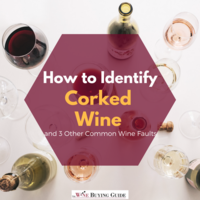How to Identify Corked Wine and 3 Other Common Wine Faults
How to spot a good wine gone bad.

You can dislike a wine for any number of reasons. It might lack nuance, have too many tannins, or it might be sweeter than you prefer. However, it’s important to know when a wine tastes terrible because there is actually something wrong with it.
Wines can have a variety of faults that will radically affect their smell and flavor. Tainted corks, improper storage, or simply becoming too old can all cause good wine to go bad. Corked wine is one of the most common wine flaws, but there are others as well. With this simple guide, you can learn how to identify common wine flaws.
What do you do if a wine is flawed? Return it. If you purchased the bottle from a wine store, it should accept a return. Bring in the bottle with the remaining tainted wine still in it. If you are at a restaurant, politely tell your server that you think the wine is spoiled. They may pour themselves a taste to confirm, but there should be no issue. This is also the purpose of the small taste the server gives you when you purchase a bottle of wine. That is your chance to check that the wine is good. If it’s not, say so!
Learning how to taste wine will help you develop your wine palate, savor the wines you drink, and even blend in at a wine tasting (if necessary!). The steps to wine tasting are simple, and they are used by everyone from wine novices to sommeliers. Wine Tasting 101: How to Taste Wine
What is Corked Wine?
Corked wine is tainted by a naturally occurring chemical called TCA. Corked wine tastes and smells musty, like moldy cardboard, wet dog, or a dank basement. A faint TCA taint might also just mute the aromas and flavors of the wine, giving you a wine that tastes very flat and dull.
Wine can only be corked if it has a real, natural cork in the bottle. Wines with synthetic corks and screw cap bottles are safe from this flaw, which affects about 5% of wines bottled with natural cork.
Corked wine is safe to drink, so you don’t have to worry about getting sick from the wine. You probably won’t want to take more than a sip or two, though!
3 Other Common Wine Flaws
Oxidized Wine
Oxidized wine has been exposed to too much oxygen. This happens when older wines aren’t aged properly or when wine isn’t drunk quickly enough after opening. Oxidized wines change color and flavor. Reds will turn orange-brown, and both red and white wines will taste drier, more bitter, and generally lose any fruit flavor. If you’ve ever left an open bottle of Chardonnay in the refrigerator for a week and a half, you may have noticed that the wine almost turns to vinegar. This is an example of extreme oxidation.
Cooked Wine
Cooked wine is almost what it sounds like. When wine gets too hot during storage, its flavor is ruined. It will taste and smell like stewed fruit. Avoid this flaw at home by always storing your wine in a cool, dark place. A telltale sign that a bottle might be “cooked” is if the cork is sticking out of the bottle slightly. The heat will have caused the liquid inside to expand, pushing out the cork.
If you’ve seen the Columbo episode “Any Old Port in a Storm,” you’ll know exactly how problematic cooked wine can be!
Lightstrike
Wine should be stored in a dark place in order to avoid this flaw. Lightstrike occurs when wine is exposed to excessive UV radiation, as happens when wine is stored in the sun or near a window. Delicate white wines are more susceptible to this flaw, which causes aromas and flavors like damp cardboard or soggy vegetables. Save your wine; don’t leave it out in the sun!
Store your wines carefully to avoid inducing these flaws into your own wine. Plus, be sure to follow the advice above for dealing with a flawed bottle of wine when you get one. Good luck!
Have you ever returned a bottle of flawed wine?
Read NextRed Wine Sweetness Chart




